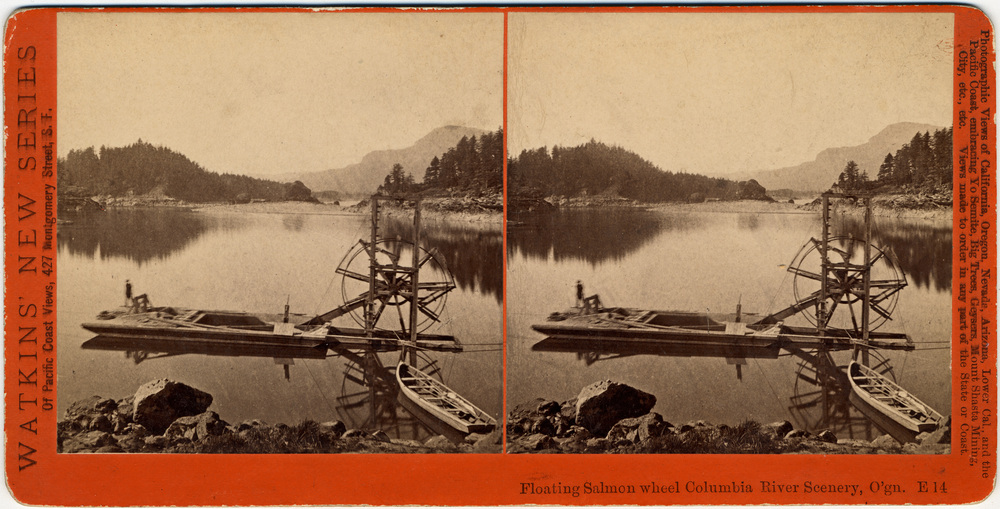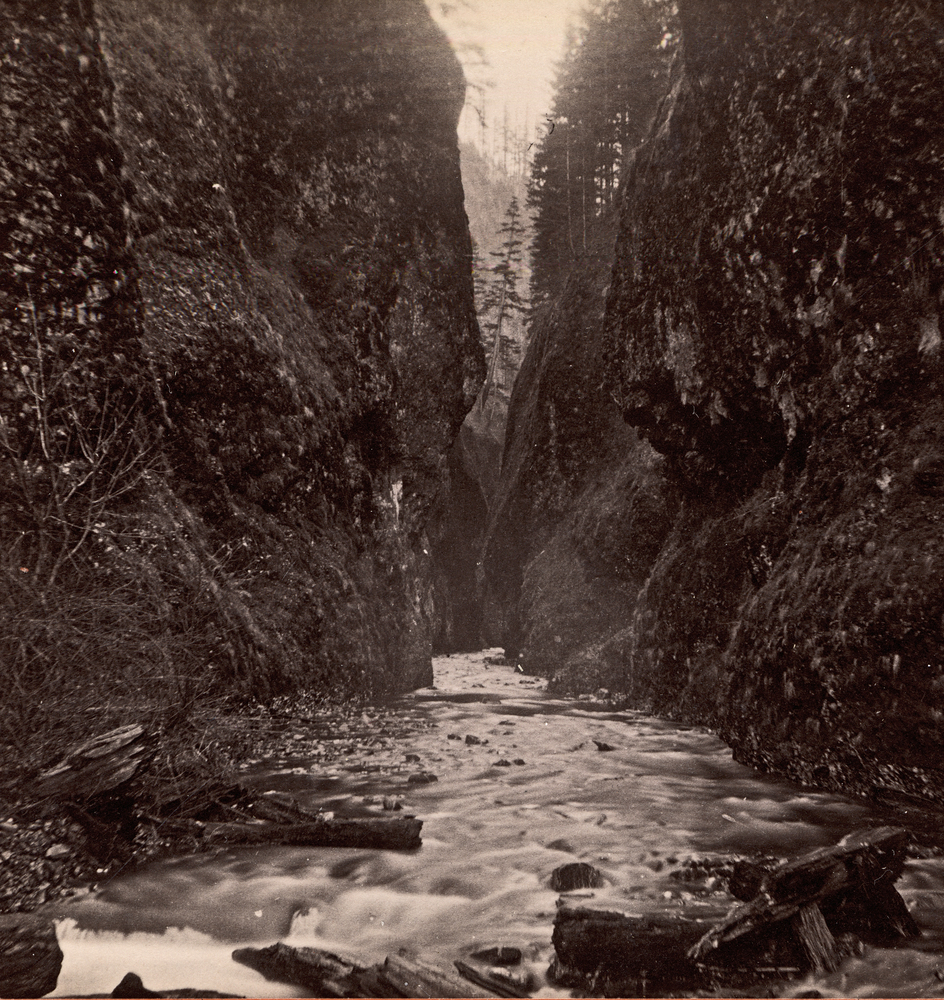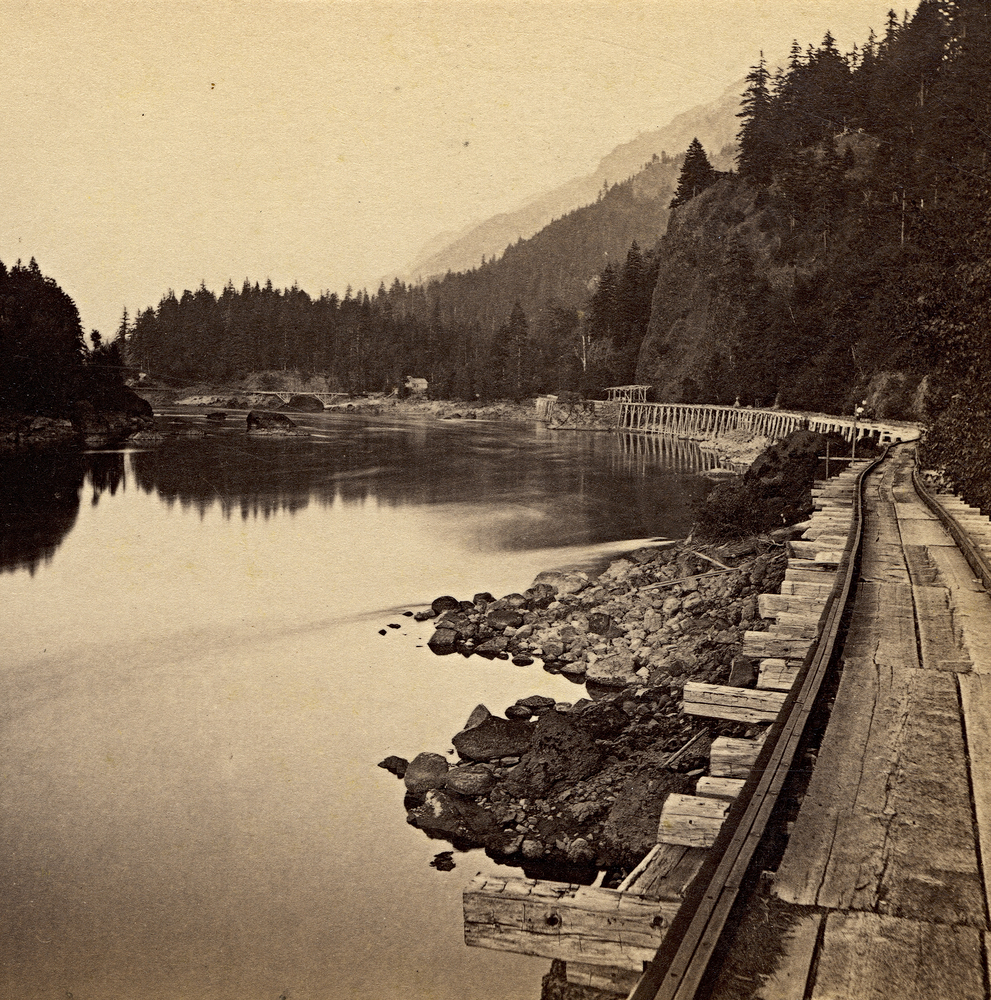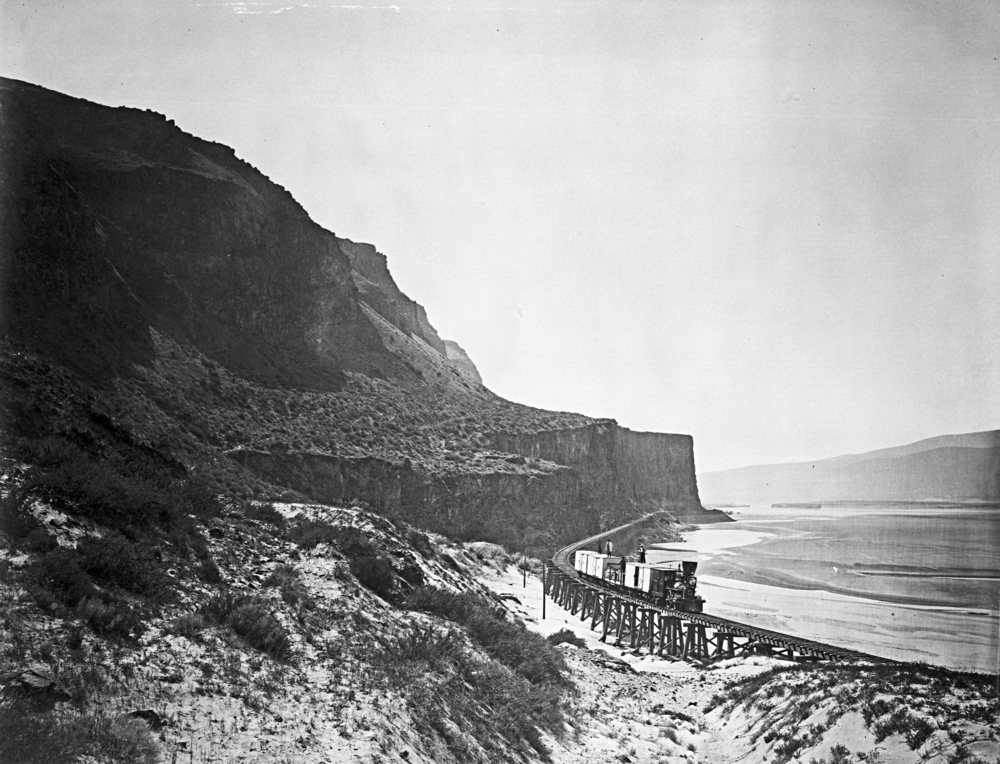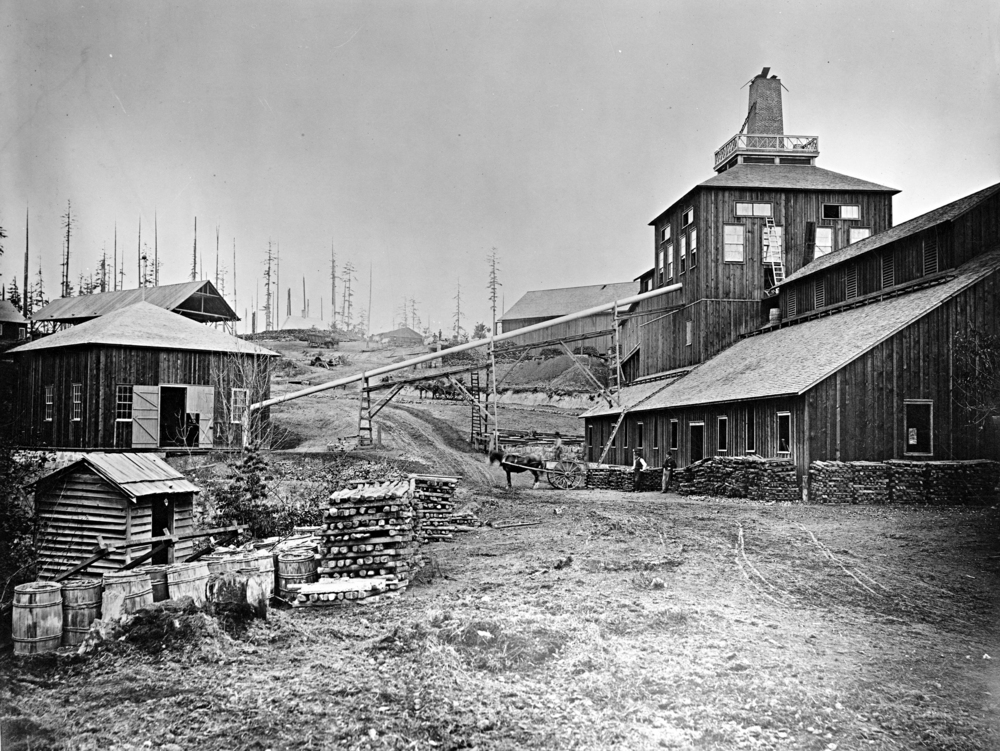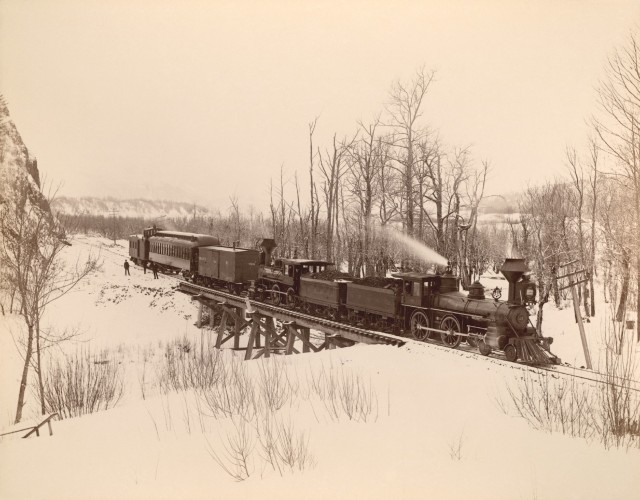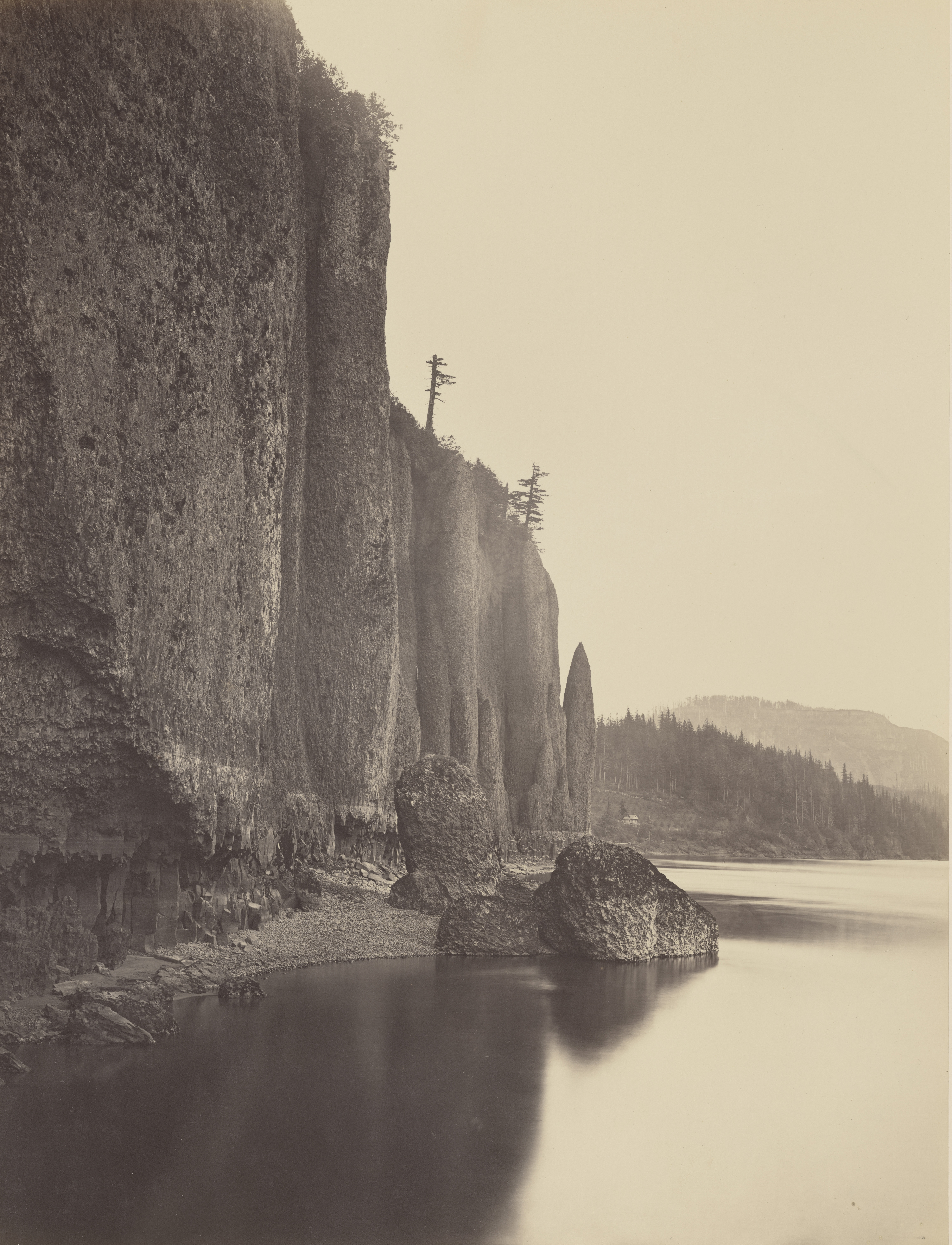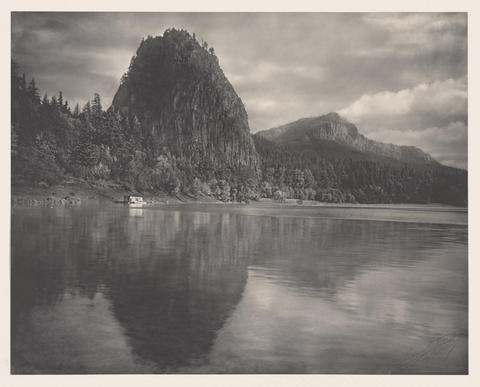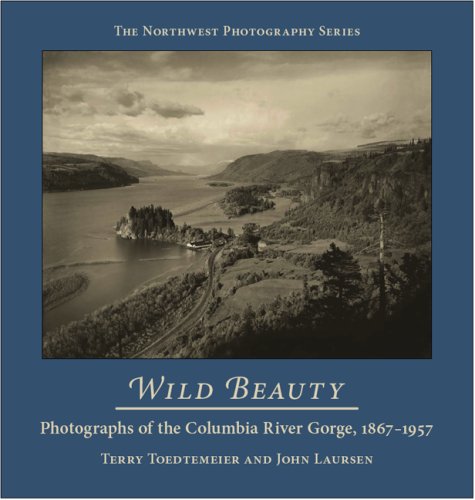Carleton Emmons Watkins was a prominent San Francisco-based photographer who first visited and photographed Oregon and the Columbia River Gorge in 1867. From July through October of that year, he traveled the upper Willamette River and the Columbia River Gorge, photographing its landscapes, early settlements, and the burgeoning railroad and steamship industry on the river. His photographs are the first known images that comprehensively document the mid-Columbia River from Portland to Celilo Falls.
Watkins was born in 1829 in Oneonta, New York. He migrated to California in 1851 and found work in the studio of pioneer daguerreotypist Robert H. Vance (1825-1876). Watkins proved to be an especially good study in the art of landscape photography, and he opened his own photography business in San Francisco in 1858. Unsatisfied with the limitations of using a standard-sized camera to capture the details of a landscape, Watkins commissioned a cabinetmaker to build an innovative bellows-format camera that could hold 18-by-22-inch glass-plate negatives.
Watkins’s first major success with the new camera came in 1861, when he photographed Yosemite at the request of the California Geological Survey. His mammoth photographs helped persuade Congress to establish the area as a natural preserve in perpetuity. Photographs from later trips to Yosemite in 1865 and 1866 also won the photographer international acclaim, and by 1867 Carleton Watkins was considered one of the premier photographers of the American West.
Watkins arrived in Portland in July 1867, determined to expand the range of his work to the Pacific Northwest. Though he photographed Portland, Oregon City, and Oswego, his real focus was the Columbia River Gorge. No photographer had ever attempted to photograph the Gorge so thoroughly. Travel was difficult and no through roads existed, so the photographer went by the Oregon Steam Navigation Company’s steamships, barges, and its portage railroads at the river’s impasses at Cascades Rapids and the Passage of the Dalles.
Watkins traveled with his mammoth camera, a stereoview camera, tripods, hundreds of glass-plate negatives, a portable darkroom tent, and the chemicals and equipment needed to develop negatives in the field. He made at least 59 mammoth plates and 139 stereoviews during his trip and captured some of the first photographs of now-iconic landmarks such as Multnomah Falls, Cape Horn, and Castle Rock (now Beacon Rock). He also photographed the Native and non-Native people who lived and worked on the river’s shores.
Despite his artistic success, increased competition in the photography market during the mid-1870s caused prices to plummet. By 1878, unable to re-pay his creditors, Watkins was forced to give them his only collateral—his original negatives. Stung by the loss, he returned to the Columbia River Gorge in the autumn of 1882 and 1883 to re-photograph the sites he had visited in 1867. He also photographed the new Oregon Railway & Navigation Company lines along the river, the construction of Cascade Locks, and areas of the Gorge that he had been unable to reach in his earlier trip, such as Mitchell Point and Oneonta Gorge.
Watkins returned again to the Gorge during the winter storm of December 1884 and January 1885, when a blizzard hit the river and trapped an Oregon Railway & Navigation Company train in snowdrifts that reached to a reported height of thirty-five feet. The photographer, who was likely in Portland to travel the railway’s transcontinental lines to Montana and Yellowstone, accompanied rescue crews and captured the efforts to dig out the tracks. He took some of the first known photographs of the snowy grandeur of the river in winter.
In the following years, Watkins’s health and finances declined, and he took on few new photographic projects. By 1903, the photographer was almost completely blind and unable to work, and on April 18, 1906, a devastating earthquake and fire rocked the city of San Francisco, destroying his entire studio, including his life’s work. Watkins never recovered from the loss and was committed to the Napa State Hospital for the Insane in 1910, where he died in 1916.
-
![Stereoscopic photo of fishing at Bradford Island, Columbia River Gorge, 1882.]()
Fishing near Bradford Is., Columbia R., Watkins, 1882, ba021024.
Stereoscopic photo of fishing at Bradford Island, Columbia River Gorge, 1882. Photo by Carleton E. Watkins, courtesy Oreg. Hist. Soc. Research Lib., ba021024
-
![Oneonta Gorge, Columbia River Gorge, 1883.]()
Oneonta Gorge, Watkins, 1883, ba021146.
Oneonta Gorge, Columbia River Gorge, 1883. Photo by Carleton E. Watkins, courtesy Oreg. Hist. Soc. Research Lib., OrHi 66386
-
![Portland Panorama 1867.]()
Portland, panorama of, by Watkins, Carleton, OrHi 13643.
Portland Panorama 1867. Photo by Carleton E. Watkins, courtesy Oreg. Hist. Soc. Research Lib., OrHi 13643
-
![Tooth Bridge, west of Eagle Creek in the Columbia River Gorge, part of the Oregon Steam Navigation Co.'s Oregon Portage Railroad around Cascades of the Columbia, 1867.]()
Tooth Bridge, Columbia R., Watkins, 1867, ba021106.
Tooth Bridge, west of Eagle Creek in the Columbia River Gorge, part of the Oregon Steam Navigation Co.'s Oregon Portage Railroad around Cascades of the Columbia, 1867. Photo by Carleton E. Watkins, courtesy Oreg. Hist. Soc. Research Lib., ba021106
-
![Portage railroad, Cape Horn, near Celilo, 1867.]()
Celilo, Cape Horn, Watkins, 1867, OrHi 21585.
Portage railroad, Cape Horn, near Celilo, 1867. Photo by Carleton E. Watkins, courtesy Oreg. Hist. Soc. Research Lib., OrHi 21585
-
![Oregon Iron Company, Lake Oswego, 1867.]()
Oregon Iron Company, Watkins, 1867, ba014669.
Oregon Iron Company, Lake Oswego, 1867. Photo by Carleton E. Watkins, courtesy Oreg. Hist. Soc. Research Lib., ba014669
-
![]()
Relief train at Bridal Veil in the Columbia Gorge, 1884.
Courtesy Oreg. Hist. Soc. Research Library, Org Lot 93
Related Entries
-
![Benjamin A. Gifford (1859–1936)]()
Benjamin A. Gifford (1859–1936)
Benjamin Arthur Gifford was one of Oregon’s most prolific commercial la…
-
![Columbia River Gorge]()
Columbia River Gorge
The Columbia River Gorge is a striking natural landscape of mountains, …
-
![Lily Edith White (1866-1944)]()
Lily Edith White (1866-1944)
Photographer Lily White once professed: "Alone—controlling the power, d…
-
![Terry Toedtemeier (1947–2008)]()
Terry Toedtemeier (1947–2008)
Terry Norman Toedtemeier was an Oregon photographer known for his image…
Related Historical Records
Map This on the Oregon History WayFinder
The Oregon History Wayfinder is an interactive map that identifies significant places, people, and events in Oregon history.
Further Reading
Friedel, Megan K. "Master of the Columbia: Photography by Carleton E. Watkins at the Oregon Historical Society." Oregon Historical Quarterly 109:3 (Fall 2008), 434-445.
Friedel, Megan K., and Terry Toedtemeier. "Picturing Progress: Carleton Watkins's 1867 Stereoviews of the Columbia River Gorge." Oregon Historical Quarterly 109:3 (Fall 2008), 388-411.
Palmquist, Peter E. Carleton E. Watkins: Photographer of the American West. Albuquerque: University of New Mexico Press for the Amon Carter Museum, 1983.
Toedtemeier, Terry, and John Laursen. Wild Beauty: Photographs of the Columbia River Gorge, 1867-1957. Corvallis, Ore.: OSU Press, 2008.

